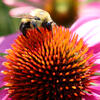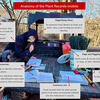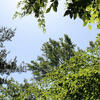We live on a green, lush world. It's up to us to keep it that way! We invite you to learn more about the trees and plants that share the planet with us from the Ambler Arboretum, the Franklin Institute, Bartlett Tree Experts and some of our other event contributors.
The Ambler Arboretum of Temple University is an educational resource modeling the art and science of horticulture and environmental responsibility while fostering research, celebrating the achievements of women in horticulture, preserving the historic significance of the campus and highlighting the health benefits of nature, plants and gardening. The Ambler Arboretum of Temple University is proud to be a part of America’s Garden Capital.
That’s Not a Pine!
When is a pine not a pine? When it’s a different tree entirely! In this video, Ambler Arboretum Director Kathleen Salisbury provides insight into what is and is not a pine in “That’s Not a Pine!”
Cone-fusion
There seems to be some confusion about cones. Sure, all pine cones are cones, but not all cones come from pines. In this video, Kathy Salisbury, Director of the Ambler Arboretum, tries to clear up some of the “Cone-fusion,” as she shares examples of many of the cones found in our campus gardens.
That’s Not a Tree!
How’d you like to pick a banana or a papaya straight from a tree? Well, you can’t because they don’t grow on trees! They the fruit of are giant herbs! Join Benjamin Snyder, Manager of the Greenhouse Education and Research Complex, to learn more about these wonderous plants!
That’s Not a Holly!
Holly is a wonderfully decorative plant, but are you sure that what you have in your yard is actually a holly? Ambler Arboretum Director Kathy Salisbury sheds a little light on the subject in “That’s Not a Holly!”
That’s Not Dead!
At this time of year while some trees and plants are slow to show off their greenery as spring deepens, you might think that your plants are dying but that probably isn’t the case! In this video from Ambler Arboretum Director Kathy Salisbury, learn about trees and shrubs that might appear dead (or at least on their last legs) but really aren’t!
Head to the Tropics with the Ambler Campus Greenhouse
Benjamin Snyder, Manager of the Greenhouse Education and Research Complex, shares fascinating facts from the Ambler Campus Greenhouse. This time we’re heading to warm climates with an exploration of tropical fruit trees, some of which you can grow at home!
Why Do We Need Plants?
This video from Whizbusters explores how plants are essential to all life on earth, from the air we breathe to protecting land and soil from washing away, we need plants!
The Life Cycle of Flowering Plants
Jared shows us the parts of a flower and describes a life cycle. He shows us that flowers need to make seeds to make more flowers. This video is used with permission from the College of Science and Technology, TuTeach and the incredible FunScienceDemos team.
Seeds and the Life Cycle of Plants
Jared explores a school garden and finds where the seeds are hiding in many of the plants. He discusses the life cycle of plants. This video is used with permission from the College of Science and Technology, TuTeach and the incredible FunScienceDemos team.
Plants and Their Seeds
Plants need their seeds to travel so that they can find a new place to grow. Jared teaches us about what makes that happen in our ongoing series of videos about the life cycles of organisms. This video is used with permission from the College of Science and Technology, TuTeach and the incredible FunScienceDemos team.
Where Can you Find Seeds?
We all know that plants come from seeds. But how does that work? And where can you find them? Franklin Institute Traveling Science Show Presenter David "Green-Thumbs" Wrigley will inspire your love of seeds.
Planting for Pollinators
Kathy Salisbury, Director of the Ambler Arboretum of Temple University, invites you to learn about Planting for Pollinators! There's more to pollinators than honey bees and butterflies. If you are looking to attract pollinators to your garden you should consider all the different types of pollinators and flower shape, size, color and scent.
Plant A Pollinator Garden: A How-to Guide

Spring is in the air! If you’re like most home gardeners you’re making a list of which flowers, herbs or crops you want to grow. You’re picturing a centerpiece of colorful flowers and that first summer bite of a juicy tomato.
Besides reaping the fruits of nature, it can also be rewarding to turn the table and consider how you can benefit nature. The small act of caring for our environment helps us get closer to nature. One way is by cultivating the right plants that will attract pollinators to your urban rooftop of container plants, suburban yard or stretch of meadow. Pollinators—including bees, butterflies, moths, wasps, beetles, bats and birds--are essential to our ecosystem because they help plants make fruit and seeds by transferring pollen from flower to flower. Learn more in this how-to guide by the Academy of Natural Sciences.
Promoting Pollinator Habitats
In this video, Tamara, an employee with U.S. EPA's Office of Chemical Safety and Pollution Prevention, demonstrates how to make a seed ball to promote pollinator habitats.
Labyrinths Offer a Path to Inner Peace

As the pandemic has heightened stress and anxiety for many Americans, this form of moving meditation can be an underutilized — and free — resource to aid in relaxation. Learn more in this article from the Philadelphia Inquier. The Ernesta Ballard Healing Garden in the Ambler Arboretum features a central labyrinth and rain garden and was developed from Temple's award-winning 2006 Pennsylvania Horticultural Society Philadelphia Flower Show exhibit, “Nature Nurtures—Mind, Body, Spirit.”
The garden, which honors a pioneering woman in horticulture, alumnus Ernesta Ballard, provides opportunities for students, faculty, researchers and the public to see comprehensive stormwater management techniques that aim at capturing and infiltrating stormwater run-off in an aesthetically pleasing design using stone and native plants. A variety of plants help rid the run-off of any contaminants.
Small Actions Spark Big Changes - Native Plants
Whether you tend to a patio garden of container plants or plan to grow a meadow, you can encourage biodiversity by providing the right native plants to feed and protect insects and small animals. Join Academy of Natural Sciences scientists and experts from Philadelphia Parks and Recreation and Longwood Gardens to learn more.
Why Native Plants
Kathy Salisbury, Director of the Ambler Arboretum shares essential information on the importance of native plants in this video from the Upper Dublin Parks and Recreation Department.
Identifying Invasive Plants
On the flip side of the importance of native plants are exotic invasive plants. Present Cindy Nuss explores insursions of invasive plants in the region and how to respond to them in this video from the Upper Dublin Parks and Recreation Department.
Flowering Plants for Shady Spots
Kathy Salisbury, Director of the Ambler Arboretum of Temple University, invites you to learn about “Flowering Plants for Shade Spots,” which highlights plants that tolerate and thrive in those shady areas of your garden. Highlighted plants include Purple Flowering Raspberry, Indian Pink, Oak Leaf Hydrangea and more!
Fragrance, Scents and Odors (Oh My!)
Join Kathy Salisbury, Director of the Ambler Arboretum of Temple University, for a walk around the Sustainable Wetland Garden to learn about plants whose leaves, flowers or fruits smell great, or not so great.
Temple Talk: Plants for Senses
In this video from the Upper Dublin Parks and Recreation Department, Kathy Salisbury, Director of the Ambler Arboretum of Temple University, talks about gardening for the senses. We've all got five senses - sight, taste, hearing, touch, and smell. You can garden to provide interest for all of your senses!
The Importance of Composting
Just just throw it all away! Compost it! This process recycles various organic materials otherwise regarded as waste products. A good compost is rich in plant nutrients and beneficial organisms. In this video from the Upper Dublin Parks and Recreation Department, Kathy Salisbury, Director of the Ambler Arboretum of Temple University, talks about composting at home.
Creating Sustainable Gardens
In this video from the Upper Dublin Parks and Recreation Department, Cindy Nuss share insight into how to make your garden do the work for you be designing your goarden for conservation and sustainability.
Ambler Arboretum Presents: EDRR — Narrow Leaf Bittercress
Kathy Salisbury, Director of the Ambler Arboretum of Temple University, invites you to learn about Early Detection Rapid Response and Narrow Leaf Bittercress. Some invasive plants are already found everywhere you look. Others are just starting to take over our natural areas. When they are just starting, we have a chance to stop the problem before it gets too bad. This is the case with Cardamine impatiens, Narrow Leaf Bittercress.
Early Detection Rapid Response (EDRR) is a technique ecologists use to control an invasive or potentially invasive plant before it becomes ubiquitous. In this video, learn how to identify Narrow Leaf Bittercress, how to tell it apart from the native Cardamine, how it spreads, where to find it and what to do when you find it.
Poison Ivy and Virginia Creeper
If Poison Ivy sends you walking (or running) in the opposite direction, have no fear! This week, Kathy Salisbury, Director of the Ambler Arboretum, invites you to learn about this important native plant during a virtual walk. She’ll also share how to tell Poison Ivy apart from the lookalike Virginia Creeper.
Spring in the Woodland Garden
Join Ambler Arboretum Director Kathy Salisbury as she provides a tour of the Woodland Garden in early spring. Although it creates the illusion of a flourishing natural woodland, the Woodland Garden was one of the first planted gardens in the Arboretum, created by students and staff in the 1920s. It was deliberately designed to evoke the atmosphere of an untamed grove, and has been enhanced over decades by the addition of masses of spring bulbs and native wildflowers.
The Colibraro Conifer Garden
Join Kathy Salisbury, Director of the Ambler Arboretum of Temple University, for an ongoing tour of the Arboretum gardens. Today we're visiting the Colibraro Conifer Garden.
Dedicated in 2010 and donated by the Colibraro family, the exquisite conifer cultivars in the Colibraro Conifer Garden create a unique teaching garden. The Colibraro family have been dedicated supporters of the Ambler Arboretum of Temple University for decades.
The garden, located in the Greenhouse Education and Research Complex, includes exquisite dwarf conifer cultivars. Adding to the special nature of this collection, the garden is surrounded by full-sized examples of some of the dwarf conifers found within, giving a unique opportunity for visitors and students alike to compare options for uses in various landscape situations.
The Ambler Arboretum "Swamp"
Bet you didn’t know that the Ambler Arboretum has its own swamp! Join Ambler Arboretum Director Kathy Salisbury as she provides a tour of this lesser-traveled area of the Arboretum. In this tour, Kathy also highlights Skunk Cabbage, a fascinating plant that most definitely lives up to its name.
Behind the Scenes at the Ambler Arboretum - Plant Records and Inventories

One of the main differences between a public garden and a public park, is the existence of a documented plant collection to support the mission of the garden. Superficially, some public parks look like gardens and some public gardens have a park-like aesthetic. But, behind every public garden are plant records that capture the history of individual plants.
What is done with these records is entirely dependent on the mission of the organization. Here at the Ambler Arboretum, our records are used to support university courses, provide details for internal and external research, and get the general public more information about plants and horticulture. Read the full story.

